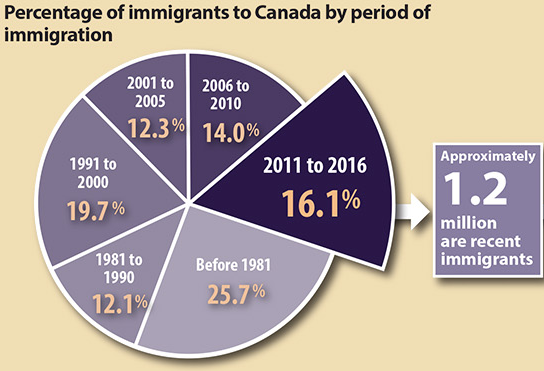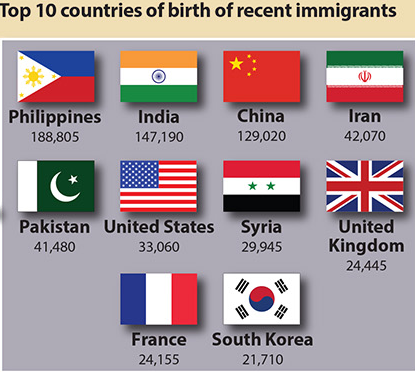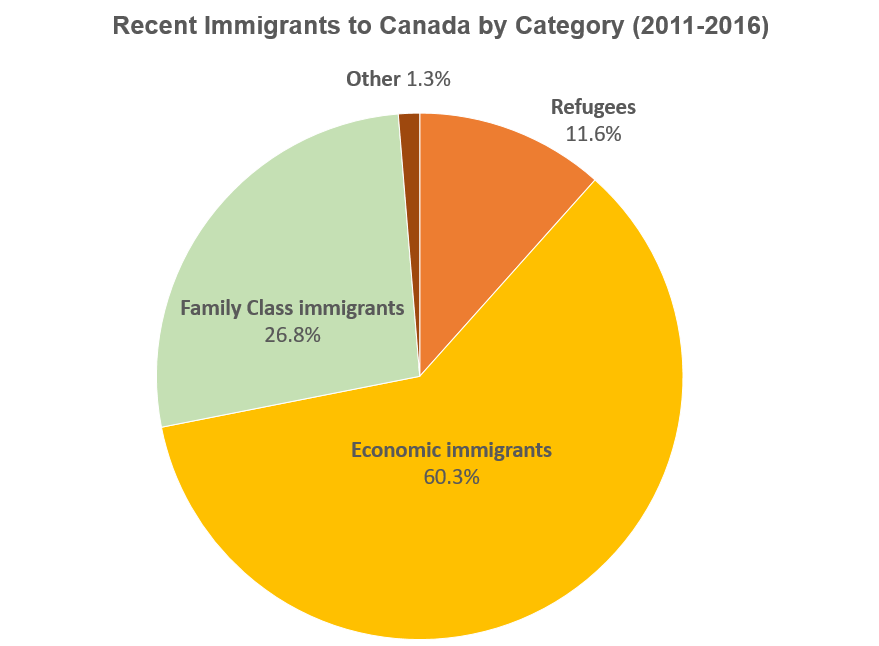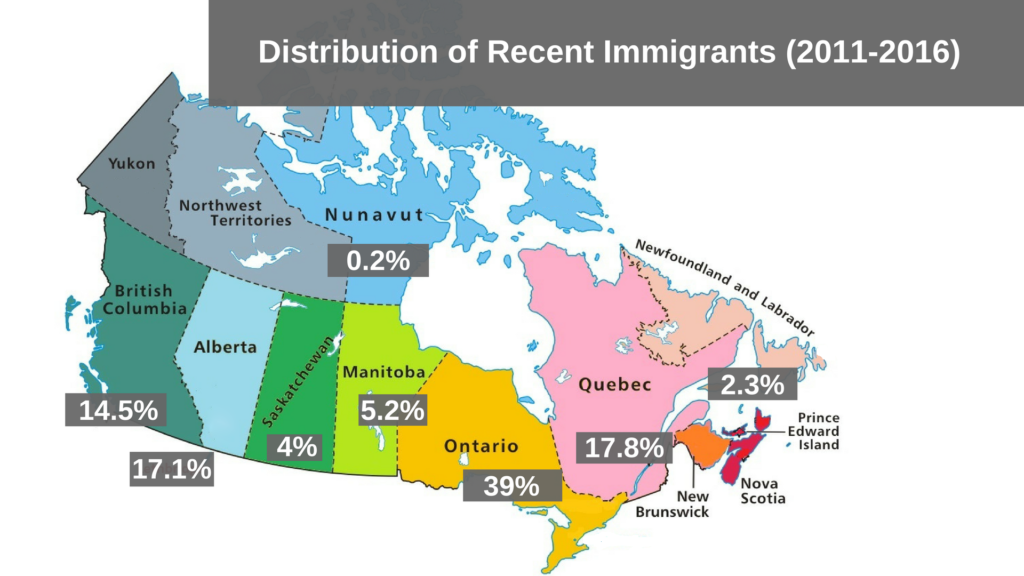Immigrants Make Up 21.9% of Canada’s Population: StatsCan
The share of Canada’s growing population made up by immigrants has risen to 21.9 percent, up from 20.6 percent in 2011, and the majority of recent immigrants arrived through an economic immigration program.
These are just a couple of the many insights published by StatsCan, based on data gathered in last year’s census. The immigrant population is defined as persons who are, or who have been, permanent residents in Canada. Immigrants who then went on to obtain Canadian citizenship by naturalization are included in this group.
You have to go back to 1921 to find the last time the share of Canada’s population made up by immigrants was this high. Back then, just under two million immigrants represented 22.3 percent of the overall population.
Today, 7.5 million immigrants are spread across the country — and despite the fact that Toronto, Vancouver, and Montreal still attract more than half, more immigrants are choosing to settle in the Prairie provinces and Atlantic Canada. Government projections show that Canada’s immigrant population may reach as high as 30 percent by 2036.

Source: IRCC
Number and proportion of foreign-born population in Canada, 1871–2036

Source: StatsCan (Note: // represents a break in the historical series)
Immigrants’ backgrounds have also shifted over time. Whereas decades ago the main sources of newcomers to Canada were Europe and the United States, the latest figures reveal that 61.8 percent were born in Asia (including the Middle East). No fewer than seven of the top 10 source countries of new immigrants were Asian: the Philippines, India, China, Iran, Pakistan, Syria, and South Korea.

Source: IRCC
For the first time ever, Africa (13.4 percent) ranks ahead of Europe (11.6 percent) as a source continent. Nigeria, Algeria, Egypt, Morocco, and Cameroon made up the top five African source countries, while the United Kingdom and France provided the largest European sources. Newcomers from the Americas and Oceania represented 12.6 percent and 0.7 percent, respectively.
The census also shows that more than three-in-five immigrants (60.3 percent) who arrived between 2011 and 2016 were admitted through an economic program. A further 26.8 percent arrived under the Family Class having been sponsored by a close relative, spouse, or common-law partner, and 11.6 percent were refugees. Around a quarter of all immigrants admitted in the first five months of 2016 were refugees, far higher than the general trend due to the government’s effort to quickly resettle displaced Syrians.
Economic arrivals are welcomed because they have the proven capability to settle into the Canadian labour market. Canada’s internationally-praised economic immigration system has undergone an overhaul during the period since previous figures like these were last released in the National Household Survey of 2011. In January, 2015, Canada’s main economic immigration programs moved from a first-come, first-served model to the Express Entry system, which allows the government to invite eligible candidates to apply for permanent residence on a priority basis. With Express Entry, Canada can bring in more of the world’s best and brightest, while also managing the supply of applications, thereby reducing processing times to less than six months in most cases.
Express Entry has proven to be a successful system, with nearly 140,000 Invitations to Apply having been issued at the time of writing. The majority of invitations have been issued this year, as Express Entry becomes the main driver of economic immigration to Canada. The Comprehensive Ranking System used to rank Express Entry candidates rewards individuals with work or study experience in Canada, meaning that Canada is able to welcome large numbers of immigrants from both outside and inside the country.

As more immigrants settle, communities across Canada are benefiting from their energy, expertise, and skills. Traditionally, most newcomers to Canada settle in one of the three largest cities: Toronto, Montreal, and Vancouver. This remains the case. In 2016, immigrants made up 46.1 percent of Toronto’s population, 23.4 percent of Montreal’s, and 40.8 percent of Vancouver’s.
However, cities and communities in the Prairie provinces (a regional term that includes Alberta, Saskatchewan, and Manitoba) are receiving higher proportions of the overall number of newcomers than before. For example, Winnipeg, the capital of Manitoba, attracted 4.3 percent of immigrants between 2011 and 2016, around double the overall share of the Canadian population that lives in that city.
Other cities in the Prairie provinces that have witnessed an increase in immigration settlement include Regina and Saskatoon in Saskatchewan, as well as Calgary and Edmonton in Alberta. Immigrants are increasingly attracted to these destinations for the employment opportunities and high living standard, among other factors.
Another region on the rise is Atlantic Canada, made up of the provinces of New Brunswick, Nova Scotia, Newfoundland, and Prince Edward Island (PEI). Together, Atlantic Canada accounts for 2.3 percent of recent immigrants to Canada, as each Atlantic province has received larger numbers of new immigrants than before.
According to the government, the way in which some provinces and territories use their Provincial Nominee Program (PNP) is one of several factors that can explain changes in the geographic distribution of newcomers to Canada. More than half of new immigrants living in PEI, New Brunswick, Manitoba, Saskatchewan, and Yukon were admitted through a PNP. Nationally, 16.4 percent of all recent immigrants — or 27.3 percent of economic migrants — arrived through a PNP.
Though Ontario remains the most popular province for recent immigrants, with 39 percent of them residing there, this figure is down from 55.9 percent as recently as 2001. It should be noted that overall immigration levels have increased over this period, and so rather than it being a case of fewer immigrants residing in Ontario, it is more a case of an increasing number of newcomers choosing other destinations. Indeed, despite the fact the overall share of recent immigrants choosing Ontario has decreased so far this century, the real number of immigrants living in that province has actually increased from just over three million to nearly four million.
The next most popular destination province for recent immigrants is Quebec (17.8 percent, up from 13.7 percent in 2001), while British Columbia received 14.5 percent, down from 19.9 percent in 2001.

“With two-in-five residents of Canada now coming from an immigrant background, either as a first- or second-generation immigrant, Canada’s success as a multicultural nation serves as a reminder to the world that there is another way to do things — a way that eschews ethno-nationalism in favour of openness and growth,” says Attorney David Cohen.
“I am particularly pleased to see that some of the traditionally more underpopulated regions, such as the Prairies and Atlantic Canada, are receiving a larger share of newcomers over recent years. This will benefit those newcomers, as well the communities they reside in. With larger communities, economies of scale should help to increase living standards across the board.
“For individuals and families wishing to make Canada their home, the projected increase in the overall immigrant population over the next two decades shows that this dream has every chance of becoming a reality. The first step should be to evaluate all your options under the currently available programs, and proceed from there.”
Pathway to citizenship
Immigrants to Canada have the opportunity to eventually become Canadian citizens. Indeed, recent changes to the Citizenship Act make it quicker and easier for permanent residents to transition to citizenship. To find out if or when you may be eligible to apply for Canadian citizenship, use the exclusive Canadian Citizenship Eligibility Calculator.
To find out if you are eligible to immigrate to Canada permanently, fill out a free online assessment form.
To find out your options for family sponsorship, fill out a free assessment family sponsorship assessment form today.
© 2017 CICNews All Rights Reserved
- Do you need Canadian immigration assistance? Contact the Contact Cohen Immigration Law firm by completing our form
- Send us your feedback or your non-legal assistance questions by emailing us at media@canadavisa.com





